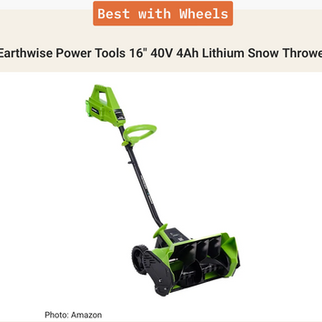The BEST Electric Snow Shovels
- pamelasjacobs
- Jan 13
- 6 min read
Updated: Mar 5
For light dustings, the traditional snow shovel design is great, but when more than a few inches have fallen, lifting and tossing heavy snow can be hard on the back and body.

Electric snow shovels look similar to manual snow shovels yet have one key difference: They are designed with electric augers that can throw snow 20 feet or more, which means they help remove winter weather from walkways, decks, and driveways faster and with less effort.
To help ease the effort you need to complete cold-weather chores this season, Bob Villa tested nine electric snow shovels and reached out to a snow-removal expert for their insights. Based on their advice and our test results, we chose the Greenworks 80V 12″ Cordless Battery Snow Shovel as the best option for most buyers. This tool is robust enough to throw snow up to 20 feet and offers an impressive 45-minute runtime for extended snow-removal sessions. Read on to learn about the key features of the best electric snow shovels and what makes the seven models that made our list stand out from the crowd.
Bob Villa's Top Picks For Electric Snow Shovels
BEST OVERALL: Greenworks 80V 12″ Cordless Battery Snow Shovel
BEST BANG FOR THE BUCK: Snow Joe 24V-SS13 Ionmax Cordless Snow Shovel Bundle
BEST LIGHTWEIGHT: Earthwise Power Tools 12″ 20V 4Ah Snow Thrower
BEST CORDED: Earthwise Power Tools 16″ 12-Amp Corded Snow Thrower
QUIETEST OPERATION: Snow Joe 24V-SS11 Ionmax Cordless Snow Shovel Kit
BEST WITH WHEELS: Earthwise Power Tools 16″ 40V 4Ah Lithium Snow Thrower
BEST HEAVY-DUTY: Ego Power+ Multi-Head Snow Shovel Kit With 4Ah Battery
Before You Buy an Electric Snow Shovel
Think of an electric snow shovel as a cross between a manual snow shovel and a larger, more powerful snow blower. The handle of an electric snow shovel resembles the handle of a traditional snow shovel, but that’s where the similarities end. Instead of a scoop blade, an electric snow shovel features a large turning blade that scoops up snow and tosses it off the path as it is pushed.
An electric snow shovel takes less physical effort to operate than a traditional shovel, but it still requires some pushing. Unlike snow blowers, electric snow shovels are typically not self-propelled. The auger does assist while it churns snow, but users will still need to push it along. And unlike blowers, electric snow shovels don’t have chutes to eject snow at different angles and trajectories; they simply eject the snow forward.
We tested nine different models in several Montana snow storms to see how they performed. We used them on various surfaces ranging from paved sidewalks and driveways to compact gravel. We found that electric snow shovels aren’t suitable for unpaved areas, such as gravel driveways, but on paved surfaces, they work impressively.
Electric snow shovels are much more affordable than snow blowers. They’re typically offered somewhere between $60 to $190, while a heavy-duty snow blower could set buyers back $1,500 or more. Electric snow shovels can help many people clear moderate snow loads from small spaces without breaking the bank.

What to Consider When Choosing an Electric Snow Shovel
Since electric snow shovels are capable of clearing snow far more easily than a conventional plastic snow shovel or metal snow shovel, they can almost be considered a clever hack for shoveling snow. When choosing the model that’s right for you, remember to consider the following key factors.
Corded vs. Cordless
Electric snow shovels come in corded and cordless designs. Each type has its own benefits and drawbacks:
Corded snow shovels offer immediate snow-clearing power: Just plug the cord into an outlet and let it rip. A corded electric model might make more sense for those who don’t want to wait for a battery to charge (which can take a few hours) before they can shovel snow. Of course, since they always need to be plugged into a power source, corded snow shovels limit the coverage area to the length of the extension cord (usually 50 to 100 feet).
Cordless snow shovels operate on rechargeable lithium-ion batteries for their power supply. They tend to run for approximately 20 to 50 minutes on a single charge. Like cordless snow blowers, a battery-operated snow shovel will have a clear advantage over a corded model if clearing snow in locations far from an outlet. Plus, users don’t have to drag a cord behind them. Still, if there’s a lot of snow to clear, users might need to stop and recharge the battery before they finish the job.
Joe Palumbo, president of Ice Dam Guys, LLC, prefers cordless electric snow shovels for his team. “We’ve found cordless, battery-powered snow shovels to be more effective than corded electric ones. While most outdoor receptacles have GFCIs, we prefer avoiding plugged-in tools near steam and water for added safety.” He also points out that “They’re a great choice if you already use a battery system for your other power tools, like Milwaukee M18, DeWalt, or Skil,” as they allow you to swap in compatible batteries you already own to increase runtime.
Clearing Area
How much snow an electric shovel can clear depends on the height and width of the intake chute. The height of the intake chute determines the maximum depth of snow the device can remove (about 4 to 8 inches). We recommend selecting an electric snow shovel with an intake chute at least as deep as the typical snowfall in your area.
Some manufacturers claim their electric snow shovels can go over deep snow with more than one pass. But if the snow is soft, these devices might sink into the snow since they’re designed to sit on a paved surface. This will just push snow over the top of the tool rather than clearing it out of the path, requiring you to use a standard shovel or ice melt.
The chute’s width determines how wide a path an electric shovel can clear in a single pass, with most chutes ranging from about 10 to 16 inches wide. A wider chute means the shovel will require fewer passes to clear an area. Some chutes have LED lights mounted on them to illuminate the work area and make snow shoveling easier at night.
Battery Life
Battery life depends on various factors, including chute size. The more snow the tool handles, the more power it requires, and the quicker the battery will drain. A battery also loses power with age, meaning it won’t hold as much charge after a few years as it did when it was new.
Generally speaking, a lithium-ion battery will run between 20 and 50 minutes on a single charge. Snow shovels with 40V batteries run about twice as long as those with 24V batteries. Investing in a second rechargeable supply can double the runtime, as users can quickly switch out the first battery if it runs out before the job is done.
Ease of Use
Whether they’re corded or cordless, the best electric snow shovels are easy to operate: Just turn them on and push them along a paved surface to remove fresh snow. The following features also affect the shovel’s usability:
Blades: Electric snow shovels work similarly to more powerful snow blowers. Their horizontal augers feature one or two blades. The auger rotates at a high speed, and the blades scoop up the snow and blow it out of an exhaust chute. Both single- and double-blade shovels will get the job done, but the double-bladed ones might clear the snow more quickly.
Scrapers: Some models have a built-in scraper that slides under the snow, which helps the blades lift snow before discharging it out of the chute.
Handles: Some of these tools have adjustable handles to fit the user’s height. More heavy-duty models often contain a second handle to help operators push the shovel through the snow.
Weight: Electric snow shovels are relatively light and typically weigh between 10 and 16 pounds. This matters because an electric snow shovel is not an automatic snow shovel, meaning you must push it along the ground rather than expecting it to propel itself. The right snow shovel will be light enough to push relatively easily but heavy enough to push into the snow rather than skim the top.
Cord length: The attached cord on a corded electric snow shovel usually isn’t longer than 6 feet. But they don’t plug right into a wall outlet anyway. Most need a 12- or 14-gauge exterior extension cord, which can be purchased separately.
The Advantages of Owning an Electric Snow Shovel
An electric snow shovel is easier to use than a manual push snow shovel and less expensive than a full-size snow blower. These shovels expedite snow removal, lessening the time spent in coats, snow boots, and winter work gloves while clearing the driveway, leaving more time for sledding, snowball fights, or staying warm indoors.
Reduces back, arm, and shoulder pain and fatigue associated with shoveling snow
Quickly removes fresh snow to an average depth of 6 to 8 inches
Lightweight and easy to handle (most weigh under 15 pounds)
Meet the Tester
Zach Lazzari is a freelance writer splitting time between the great outdoors, travel, and DIY projects ranging from camper builds to home renovations and maintenance. His home base in Montana is the perfect testing grounds for winter products and snow equipment. With over a decade of professional writing experience, he also covers a variety of other projects and maintenance topics for Bobvila.com.
Additional research provided by Glenda Taylor, Tony Carrick, and Jasmine Harding.












Comments